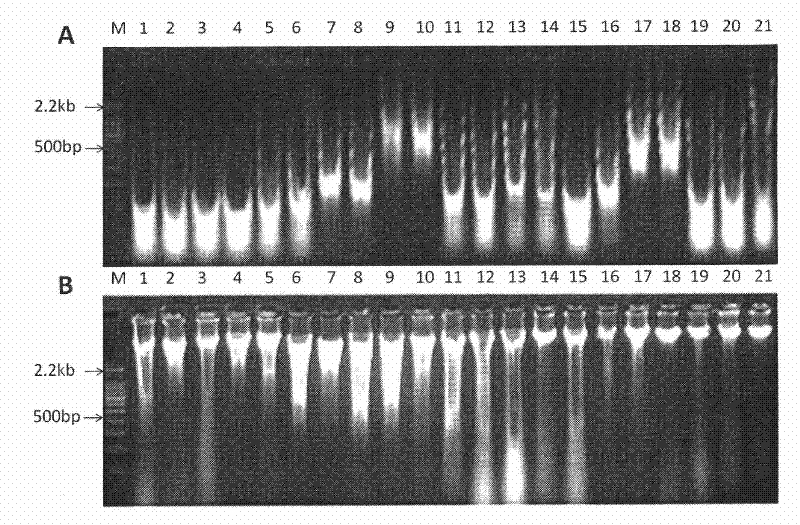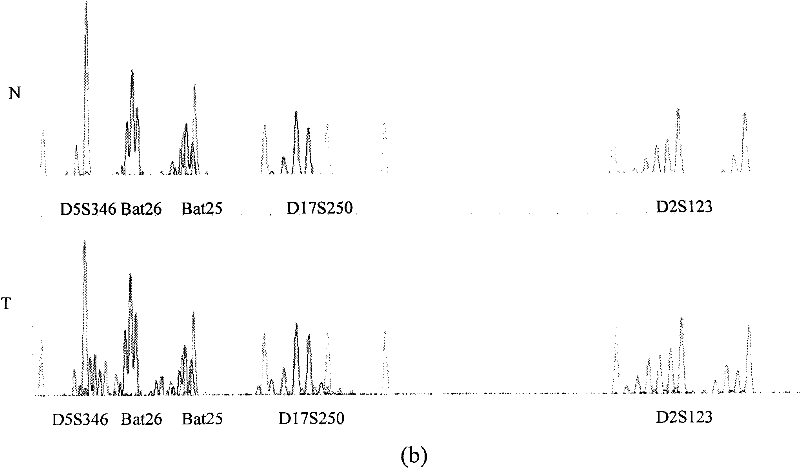Method for extracting DNA from old formalin-fixed tissues
A technique of formalin and tissue, which is applied in the field of molecular biology detection, can solve problems such as lack of stability of the method, and achieve the effect of high purity
- Summary
- Abstract
- Description
- Claims
- Application Information
AI Technical Summary
Problems solved by technology
Method used
Image
Examples
Embodiment 1
[0024] 1) Take 45mg of tissue, put it into a clean 5ml test tube, add 2.5ml of ddH2O into the test tube, put the test tube into a beaker, add water into the beaker, the amount of water should be just above the liquid level of the test tube, microwave Heating with 500W power for 3 minutes, replacing the water in the test tube, then heating with 500W power microwave for 2 minutes, and taking out the tissue;
[0025] 2) Cut the tissue into pieces, blot dry with filter paper, and soak in ethanol with gradient concentrations in sequence: 70% for 2 hours; 80% for 0.5 hours; 90% for 0.5 hours; 95% for 0.5 hours; 100% for 0.5 hours;
[0026] 3) Soak in 0.5×phosphate buffer solution twice for 0.5 hour, filter paper to absorb the phosphate buffer solution;
[0027] 4) Add 600 μl of ordinary tissue lysate, grind it into a homogenate, transfer it into a 2ml centrifuge tube, add 15 μl of proteinase K at a concentration of 20 mg / ml, and digest in a water bath at 55°C until the solution beco...
Embodiment 2
[0035] 1) Take 55mg of tissue, put it into a clean 5ml test tube, add 3ml of ddH2O into the test tube, put the test tube into a beaker, add water into the beaker, the amount of water should be just above the liquid level of the test tube, microwave 500W Power heating for 3 minutes, replace the water in the test tube, then microwave heating with 500W power for 2 minutes, and take out the tissue;
[0036] 2) Cut the tissue into pieces, blot dry with filter paper, and soak in ethanol with gradient concentrations in sequence: 70% for 2 hours; 80% for 0.5 hours; 90% for 0.5 hours; 95% for 0.5 hours; 100% for 0.5 hours;
[0037] 3) Soak in 0.5×phosphate buffer solution twice for 0.5 hour, filter paper to absorb the phosphate buffer solution;
[0038] 4) Add 1000 μl of ordinary tissue lysate, grind it into a homogenate, transfer it into a 2ml centrifuge tube, add 20 μl of proteinase K at a concentration of 20 mg / ml, and digest in a water bath at 55°C until the solution becomes comple...
Embodiment 3
[0046] 1) Take 50mg of tissue, put it into a clean 5ml test tube, add 2.75ml of ddH2O into the test tube, put the test tube into a beaker, add water into the beaker, the amount of water is just above the liquid level of the test tube, microwave Heating with 500W power for 3 minutes, replacing the water in the test tube, then heating with 500W power microwave for 2 minutes, and taking out the tissue;
[0047] 2) Cut the tissue into pieces, blot dry with filter paper, and soak in ethanol with gradient concentrations in sequence: 70% for 2 hours; 80% for 0.5 hours; 90% for 0.5 hours; 95% for 0.5 hours; 100% for 0.5 hours;
[0048] 3) Soak in 0.5×phosphate buffer solution twice for 0.5 hour, filter paper to absorb the phosphate buffer solution;
[0049] 4) Add 800 μl of ordinary tissue lysate, grind it into a homogenate, transfer it into a 2ml centrifuge tube, add 17.5 μl of proteinase K at a concentration of 20 mg / ml, and digest in a water bath at 55°C until the solution becomes ...
PUM
 Login to View More
Login to View More Abstract
Description
Claims
Application Information
 Login to View More
Login to View More - R&D
- Intellectual Property
- Life Sciences
- Materials
- Tech Scout
- Unparalleled Data Quality
- Higher Quality Content
- 60% Fewer Hallucinations
Browse by: Latest US Patents, China's latest patents, Technical Efficacy Thesaurus, Application Domain, Technology Topic, Popular Technical Reports.
© 2025 PatSnap. All rights reserved.Legal|Privacy policy|Modern Slavery Act Transparency Statement|Sitemap|About US| Contact US: help@patsnap.com



